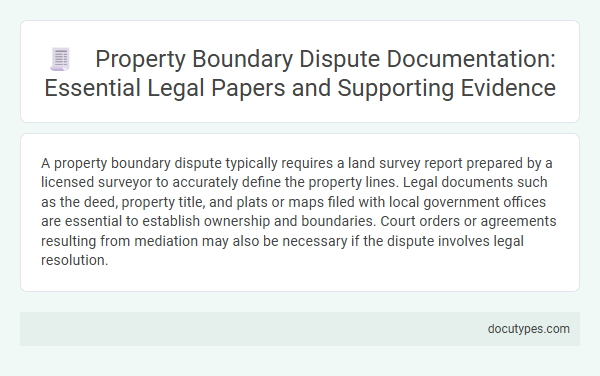A property boundary dispute typically requires a land survey report prepared by a licensed surveyor to accurately define the property lines. Legal documents such as the deed, property title, and plats or maps filed with local government offices are essential to establish ownership and boundaries. Court orders or agreements resulting from mediation may also be necessary if the dispute involves legal resolution.
Introduction to Property Boundary Disputes
Property boundary disputes arise when there is uncertainty or disagreement over the precise lines dividing land ownership. Resolving these disputes requires specific legal documents to establish clear property limits.
- Title Deed - A legal document that proves ownership and outlines the property's boundaries.
- Survey Plan - A detailed map prepared by a licensed surveyor showing the exact measurements and boundaries of the property.
- Boundary Agreement - A formal agreement between neighboring property owners that confirms and resolves boundary differences.
Key Legal Papers in Boundary Dispute Resolution
Resolving property boundary disputes requires specific legal documents that clearly define land ownership and limits. Understanding the essential papers helps streamline dispute resolution and protects property rights.
- Title Deed - A legal document proving ownership and boundaries of a property.
- Survey Map - A detailed map created by a licensed surveyor outlining exact boundary lines.
- Property Tax Records - Government-issued documents showing property boundaries used for taxation purposes.
Importance of Property Deeds and Titles
Property deeds and titles are essential documents in resolving property boundary disputes, serving as the primary legal proof of ownership and property dimensions. These documents detail the exact boundaries, ownership history, and any easements or encumbrances, providing clarity during disagreements. Accurate and up-to-date deeds and titles help prevent conflicts and support legal claims in court when boundary issues arise.
Land Survey Reports and Plats
Resolving property boundary disputes requires precise and authoritative documentation. Two critical documents are Land Survey Reports and Plats, which provide detailed information about property lines.
- Land Survey Report - A comprehensive analysis created by licensed surveyors detailing exact property boundaries and physical markers.
- Plat - A scaled map illustrating the divisions of land, showing property lines, dimensions, and easements in a visual format.
- Legal Authority - Both documents serve as legal evidence in court or mediation to clarify and settle boundary disagreements.
Your access to accurate Land Survey Reports and Plats is essential for confidently addressing boundary conflicts.
Utilizing Historical Maps and Records
Property boundary disputes require precise documentation to establish and clarify ownership lines. Historical maps and records serve as critical evidence in resolving these conflicts by providing detailed insights into original property boundaries.
These documents often include cadastral maps, survey plats, and old land grants that demonstrate how property lines were defined over time. Utilizing these records allows you to compare past and present boundaries, helping to support your claim or resolve discrepancies effectively.
Neighbor Agreements and Correspondence
| Document Type | Description | Importance in Boundary Disputes |
|---|---|---|
| Neighbor Agreements | Written agreements signed by property owners outlining mutually accepted boundary lines and conditions. | Serve as clear evidence of boundary decisions and reduce the risk of future conflicts or legal disputes. |
| Correspondence Between Neighbors | Letters, emails, or messages discussing boundary concerns, proposals, or negotiations. | Document ongoing communication and attempts to resolve boundary issues amicably; support claims in legal proceedings. |
Photographic and Video Documentation
Photographic and video documentation plays a crucial role in resolving property boundary disputes by providing clear visual evidence of the current state of the land. High-resolution photos and videos showing landmarks, fences, and natural boundaries help establish accurate property lines. You should ensure that these images are time-stamped and taken from multiple angles to support your case effectively.
Expert Witness Statements and Affidavits
What type of document is needed for property boundary disputes? Expert witness statements provide detailed observations and professional opinions crucial for clarifying boundary lines. Affidavits offer sworn, written testimonies that legally support claims regarding property boundaries.
Relevant Local Zoning and Land Use Laws
Property boundary disputes require specific documents to clarify ownership and legal boundaries. Relevant local zoning and land use laws play a crucial role in determining the validity of these boundaries.
Essential documents include property deeds, which provide official records of ownership and demarcation. Survey plats prepared by licensed surveyors offer precise boundary measurements and are often required in disputes. Local zoning ordinances and land use regulations must be reviewed to understand permissible property use and potential restrictions affecting boundary lines.
What Type of Document Is Needed for Property Boundary Disputes? Infographic

